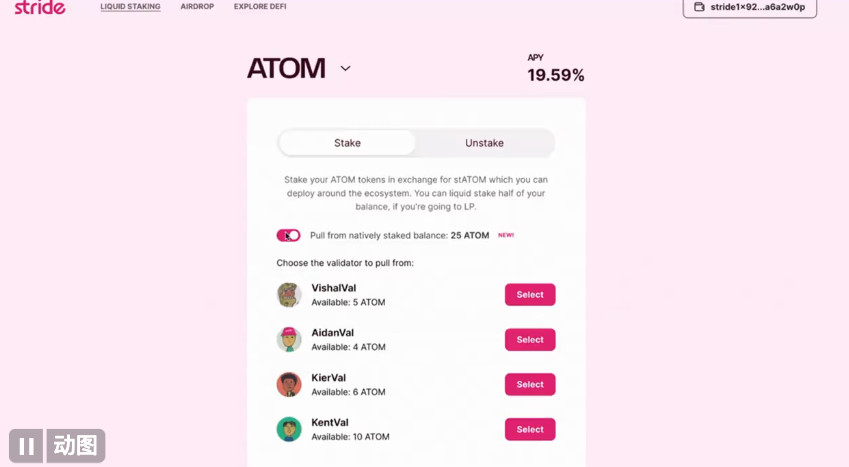Original author: Jiang Haibo, PANews
Recently, Cosmos Hub completed the Gais v1 2 upgrade and introduced the Liquidity Staking Module (LSM). Similar to other blockchains that use the PoS mechanism, there are already many projects that provide liquidity staking services in the Cosmos ecosystem, including Stride, pSTAKE, Quicksilver, Stafi, etc. What is LSM? Why is LSM specifically introduced? What are they? What impact do functions and limitations have on the Cosmos ecosystem? In this article, PANews will answer them all for you.
What is LSM? Why do you need LSM? How to achieve it?
LSM is an ATOM staking alternative in Cosmos Hub that allows users to convert staked ATOM into Liquidity Staking Derivatives (LSD), aiming to promote the adoption of ATOM liquidity staking more safely and efficiently. That is, it both facilitates the development of ATOM liquidity staking and is a form of regulation that establishes a security framework and controls the adoption of liquidity staking through governance.
Cosmos Hub needs to embrace liquidity staking, and Cosmos DeFi needs more high-quality funds. LSD that can generate income is a good source of funds. However, more funds participating in liquidity staking will also bring risks. For example, if the pledge amount accumulated by the liquidity staking service provider exceeds 1/3 of the total pledge amount, it will bring governance risks to the PoS chain; in order To prevent validators from committing malicious acts, the interests of validators and pledgers need to be consistent; in order to prevent a large amount of LST from being used as collateral to trigger serial liquidations, the adoption of LSD needs to be restricted.
Judging from the actual situation, the method of converting Cosmos Hubs staked ATOM to LSM is very simple. Currently, Stride has compiled a 3-step tutorial for converting staked ATOM to stATOM:
1. Select Withdraw from native staking balance on the Stride staking page to use the staked ATOM.
2. Select a validator and the amount of ATOM you want to stake for liquidity.
3. Sign and confirm according to the steps of liquidity staking.

What are the capabilities and limitations of LSM?
1. Staked ATOM can be converted into LSD
We know that after ATOM is directly bound (staking) in Cosmos Hub, you need to wait for a 21-day unbinding period before you can redeem it. According to CoinGecko data, as of September 15, ATOMs market value was US$2 billion, ranking 30th; Stakingreward data shows that ATOMs pledge rate is 68.12%, and the pledge yield is 20.42%. This shows that there are many people and a large amount of funds participating in ATOM staking, and the 21-day unbonding period is longer than most PoS public chains, causing inconvenience to users.
The main function of LSM is to convert ATOM that has been pledged in the Cosmos Hub into various LSDs, such as Stride’s stATOM. For users who want to exit in time, these LSDs can be sold directly in the DEX to avoid the 21-day unbinding period.
Cosmos Hub introduces this feature to promote the development of ATOM liquidity staking. LSD is one of the important sources of funds in DeFi. When PANews counted various liquidity staking programs in Cosmos in April this year, the results showed that ATOM pledged through liquidity only accounted for 1.15% of the ATOM pledged amount, which was insufficient compared to the total ATOM amount. 1% . Promoting the adoption of ATOM liquidity staking can provide more liquidity to Cosmos DeFi.
2. Verifiers need to bind ATOM themselves to accept pledge delegation.
LSM introduces an additional security feature that requires validators to stake a certain amount of ATOM themselves before they can accept delegated staked ATOM from a liquidity staking service provider.
There is a parameter involved here - the Validator Bond Factor (ValidatorBondFactor), that is, for every ATOM pledged by the validator himself, he is eligible to receive the number of entrusted pledged ATOMs from the liquidity staking service provider. Currently, this parameter is set to 250.
Through this parameter, not only can the verifier be required to reach a certain degree of interest-related relationship with the Cosmos ecosystem, but the commission earned from the liquidity staking service provider can also cover the cost of the verifiers own staking, so as not to cause excessive High burden.
3. Limit the proportion of liquidity staking to 25%
According to current data, in the PoS public chain, the liquidity of ETH pledged is about 23%. Since Lido’s market share in ETH pledge has exceeded 30%, the issue of Lido centralization has been discussed.
LSM limits the proportion of ATOM staked through liquidity staking service providers to 25% of the total amount of ATOM. When the proposal to introduce LSM was launched in April, there were 223 million ATOM staked, so the liquidity staked ATOM will be limited to 55.69 million. There is still a big gap between this value and the actual situation where the liquidity staking ratio we calculated at that time was less than 1% of the total amount of ATOM, which means that it is difficult to reach the upper limit of 25% in the short term.
This restriction is to prevent the ATOM pledge amount collectively controlled by liquidity staking service providers from reaching 1/3 of the ATOM pledge amount and to prevent nodes from collaborating to cause evil.
May promote the adoption of liquidity staking and have a greater impact on leading projects
Since the current liquidity staking ratio of ATOM is far from the 25% limit of the total amount, the update of LSM is more beneficial to the Cosmos ecosystem.
LSM is conducive to increasing the liquidity staking ratio of ATOM and the funds participating in DeFi in Cosmos. Since ATOM already staked in the Cosmos Hub can also be converted to LSD, LSD adoption may be boosted. In addition, after the introduction of LSM, it can be considered that these liquidity staking service providers are supervised by the Cosmos Hub to a certain extent, which may make stakers more recognized for liquidity staking providers.
The benefits for leading liquidity staking service providers may be even greater. This is true in both Ethereum and Cosmos. The liquidity staking service provider with the largest market share has gained far more share than the second largest. They have better network effects, and the LSD issued has more application scenarios and liquidity. In terms of revenue, It is the best choice when the rates are similar. Corresponding to the Cosmos ecosystem, the largest project in the field of liquidity staking is currently Stride, and the price of its native token STRD has also been affected and increased.



